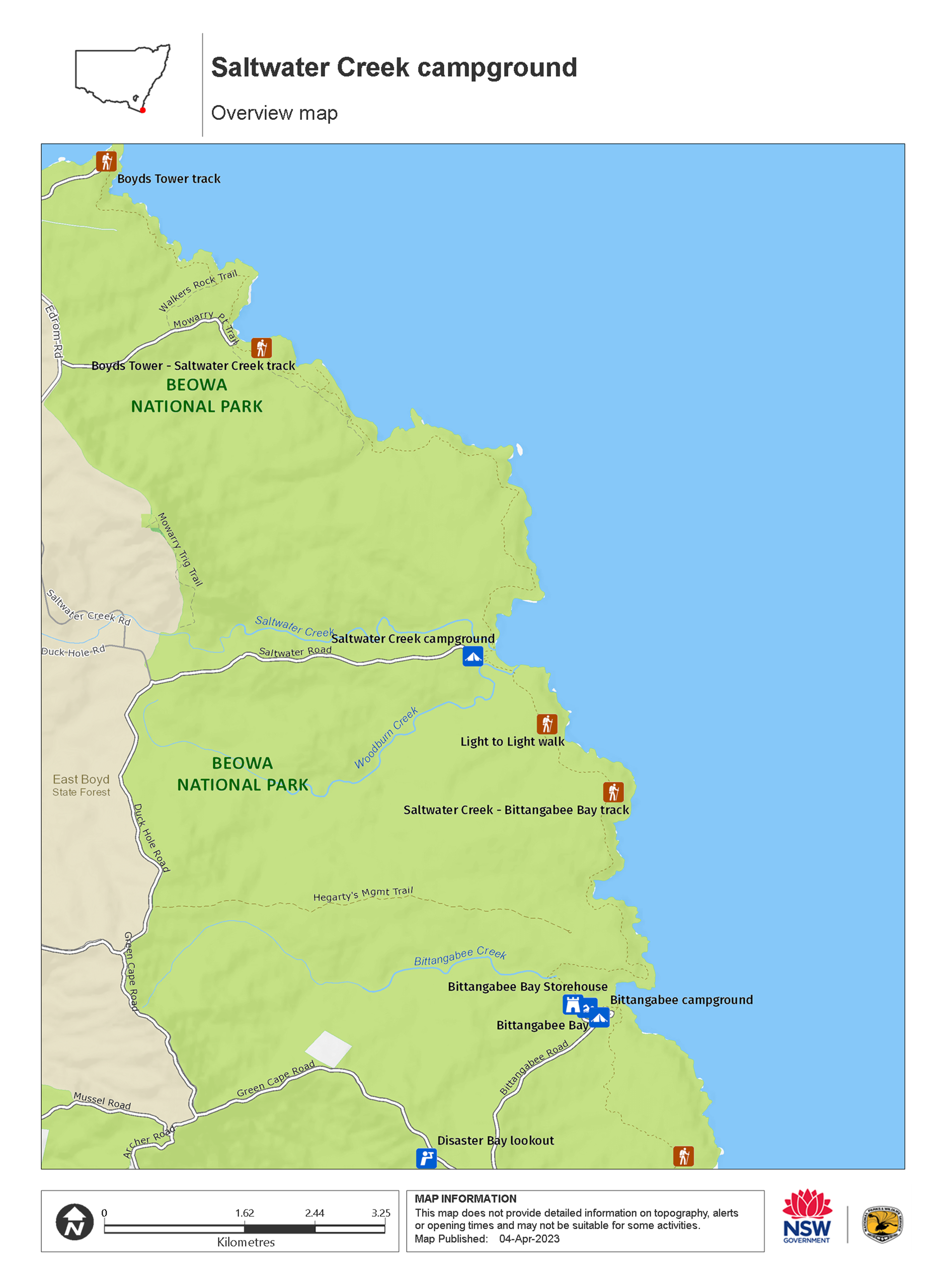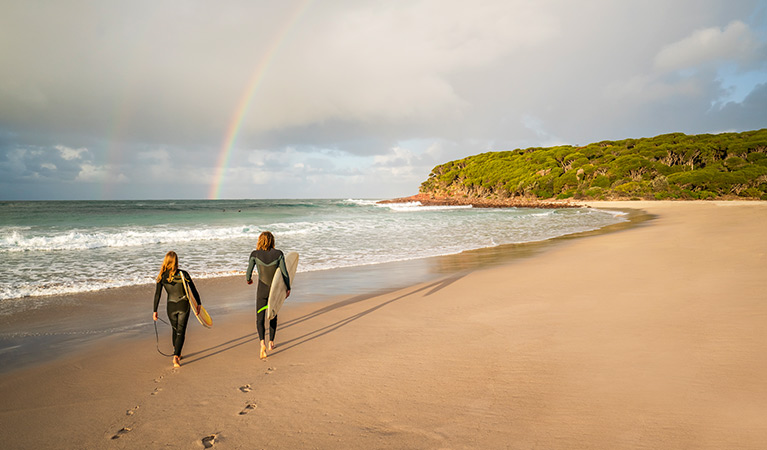Saltwater Creek campground
Green Cape area in Beowa National Park
Overview
Remote and secluded, Saltwater Creek campground offers swimming, fishing, surfing, paddling and walking in Beowa National Park, near Eden on the far south coast.
| Number of campsites | 15 |
|---|---|
| Camping type | Tent, Camper trailer site, Camping beside my vehicle |
| Facilities | Picnic tables, barbecue facilities, carpark, toilets |
| What to bring | Drinking water, cooking water, firewood |
| Entry fees |
Park entry fees are not included in your camping fees. |
| Group bookings | Book up to 40 people or 9 sites online. For larger groups, make a group booking enquiry. |
| Please note |
|
If you love remote and intimate camping far from the crowds, you’ll love the dramatic coastal setting of Saltwater Creek campground in Beowa Boyd National Park, on the far south coast. Not far from Eden, it’s the perfect getaway for nature-loving campers keen to escape the hustle and bustle of the modern world.
Once you’ve set up the tent among the rough barked apple gums, head to the pristine beach for a swim, a surf, or try your hand at fishing. There are several shallow lagoons perfect for the little ones or a spot of paddling. The campsite is a stopover on the famous Light to Light walk so take your hiking boots if you want to explore on foot.
The nearby bush is alive with wildlife all year round. You could see possums, bandicoots, red-necked wallabies, goannas, pythons and lyrebirds. Dolphins are often seen surfing the waves as whales pass by on their annual migration.
Take a virtual tour of Saltwater Creek campground captured with Google Street View Trekker.
Map

Map legend

Local alerts
For the latest updates on fires, closures and other alerts in this area, see https://www.nationalparks.nsw.gov.au/camping-and-accommodation/campgrounds/saltwater-creek-campground/local-alerts
Bookings
- National Parks Contact Centre
- 7am to 7pm daily
- 1300 072 757 (13000 PARKS) for the cost of a local call within Australia excluding mobiles
- parks.info@environment.nsw.gov.au
Operated by
- Merimbula office
- Monday to Friday and some weekends during peak holiday periods, 10am to 3pm.
- 02 6495 5000
- npws.sapphirecoast@environment.nsw.gov.au
- 47 Merimbula Drive, cnr Sapphire Coast Drive, Merimbula NSW 2548
Park info
- in the Green Cape area of Beowa National Park in the South Coast region
The Green Cape area of Beowa National Park is always open but may have to close at times due to poor weather or fire danger.
-
$8 per vehicle per day in the Green Cape area of the park (south of Eden).
Buy annual pass.
Visitor info
All the practical information you need to know about Saltwater Creek campground.
Maps and downloads
Learn more
Saltwater Creek campground is in Green Cape area. Here are just some of the reasons why this park is special:
Aboriginal culture

The Yuin People are the Traditional Owners and Custodians of Beowa National Park and they have a long and complex relationship with the coastal environment. At Twofold Bay, the Yuin People had a special relationship with the orca whales. The orcas drove humpback whales into shore, the people used spears to kill them and the orcas and people shared the meat. Aboriginal people later taught European settlers to work with orca whales during the shore-based whaling days of Twofold Bay.
- Boyds Tower walking track Take an easy walk to historic Boyds Tower near Eden, find out about local history and marine animals, and enjoy whale watching from the lookouts.
Giants of the deep

Enjoy some of Australia’s best whale watching here between September and November when hundreds of whales and their calves move in to Twofold Bay to frolic and feed before migrating south to Antarctica. You can get a good view of Twofold Bay from the viewing platform at Boyds Tower. At the southern tip of the park, see if you can spot whales near Green Cape Lightstation or Disaster Bay lookout.
- Green Cape lookout Green Cape lookout in Beowa National Park is one of the best places to enjoy whale watching in NSW.
Rocks tell a story

Beowa’s stunning rock formations, inlets and headlands are the result of extensive geological folding. Most of the park lies on red, brown and green shales, sandstones, siltstones and quartzites. They were formed in the Devonian period around 360 million years ago—before dinosaurs roamed the earth. You can see these rock types exposed along the cliffs and headlands. The Devonian period is known as The Age of Fishes and internationally-significant fish fossils have been found in several places along the park’s coastline.
- Green Cape loop walking track Only 45 minutes from Eden in Beowa National Park, Green Cape loop walking track feels remote and wild. Its crashing seas, crimson rocks, bushland and wildlife will inspire all your senses.
- Light to Light Walk Discover the wild beauty of the Far South Coast on the 32km Light to Light Walk, near Eden. Camp with views of the ocean at remote coastal campgrounds and end your walk at the southernmost lighthouse in NSW.
Vulnerable species

The heathland in the Green Cape area of the park provides significant habitat for vulnerable species like the eastern ground parrot and striated fieldwren. It’s also a stronghold for NSW’s population of the endangered southern brown bandicoot. Around 50 native mammals and nearly 150 species of birds have been recorded in Beowa National Park, including 1 critically endangered bird, 4 endangered animal species and 25 vulnerable species.
- Boyds Tower Boyds Tower is the starting point of the Light to Light Walk. Near Eden, this accessible landmark tells the story of Benjamin Boyd who built the tower in 1847. Visit for some of the best whale watching on the NSW south coast.
- Boyds Tower walking track Take an easy walk to historic Boyds Tower near Eden, find out about local history and marine animals, and enjoy whale watching from the lookouts.
- Green Cape loop walking track Only 45 minutes from Eden in Beowa National Park, Green Cape loop walking track feels remote and wild. Its crashing seas, crimson rocks, bushland and wildlife will inspire all your senses.
- Light to Light Walk Discover the wild beauty of the Far South Coast on the 32km Light to Light Walk, near Eden. Camp with views of the ocean at remote coastal campgrounds and end your walk at the southernmost lighthouse in NSW.
Fascinating coastal heritage

The first shore-based whaling station on mainland Australia was set up at Twofold Bay in 1828. Benjamin Boyd established a competing business and built a private lighthouse, Boyd's Tower, and a township, Boydtown, before being declared bankrupt. The coast was the site of many shipwrecks. Green Cape Lighthstation started operation in 1883 but shipwrecks continued, including the Ly-ee-moon that sank in 1886. You can pay your respects to some of the 76 victims at a graveyard a short walk from the lighthouse. There are also regular guided tours of the lighthouse.
- Boyds Tower Boyds Tower is the starting point of the Light to Light Walk. Near Eden, this accessible landmark tells the story of Benjamin Boyd who built the tower in 1847. Visit for some of the best whale watching on the NSW south coast.
- Boyds Tower walking track Take an easy walk to historic Boyds Tower near Eden, find out about local history and marine animals, and enjoy whale watching from the lookouts.
- Green Cape Lighthouse guided tour Uncover the history of Green Cape Lighthouse on this guided tour in Beowa National Park, near Eden. Hear stories of disaster and survival and enjoy shore-based whale watching and breathtaking views.
Plants and animals protected in this park
Animals
-

Yellow-tailed black cockatoo (Calyptorhynchus funereus)
The yellow-tailed black cockatoo is one of the largest species of parrot. With dusty-black plumage, they have a yellow tail and cheek patch. They’re easily spotted while bird watching, as they feed on seeds in native forests and pine plantations.
-

White-bellied sea eagle (Haliaeetus leucogaster)
White-bellied sea eagles can be easily identified by their white tail and dark grey wings. These raptors are often spotted cruising the coastal breezes throughout Australia, and make for some scenic bird watching. Powerful Australian birds of prey, they are known to mate for life, and return each year to the same nest to breed.
-

Superb lyrebird (Menura novaehollandiae)
With a complex mimicking call and an elaborate courtship dance to match, the superb lyrebird is one of the most spectacular Australian animals. A bird watching must-see, the superb lyrebird can be found in rainforests and wet woodlands across eastern NSW and Victoria.
-

Eastern ground parrot (Pezoporus wallicus wallicus)
The eastern ground parrot is a beautiful, ground-dwelling native bird that lives in low heathland habitat along the NSW North and South coasts and escarpments. It’s listed as a vulnerable species in NSW.
-

Lace monitor (Varanus varius)
One of Australia’s largest lizards, the carnivorous tree-dwelling lace monitor, or tree goanna, can grow to 2m in length and is found in forests and coastal tablelands across eastern Australia. These Australian animals are typically dark blue in colour with whitish spots or blotches.
Plants
-

Black sheoak (Allocasuarina littoralis)
The black sheoak is one of a number of casuarina species found across the east coast of Australia and nearby tablelands. Growing to a height of 5-15m, these hardy Australian native plants can survive in poor or sandy soils. The barrel-shaped cone of the black sheoak grows to 10-30mm long.
-

Grey mangrove (Avicennia marina)
Grey mangrove is the most common and widespread mangrove found within intertidal zones across Australia, and throughout the world. Growing to a height of 3-10m, they thrive best in estuaries with a mix of fresh and salt water. They excrete excess salt through their long thick leaves, and absorb oxygen through their aerial root system.
-

Old man banksia (Banksia serrata)
Hardy Australian native plants, old man banksias can be found along the coast, and in the dry sclerophyll forests and sandstone mountain ranges of NSW. With roughened bark and gnarled limbs, they produce a distinctive cylindrical yellow-green banksia flower which blossoms from summer to early autumn.
Environments in this area
Bookings
- National Parks Contact Centre
- 7am to 7pm daily
- 1300 072 757 (13000 PARKS) for the cost of a local call within Australia excluding mobiles
- parks.info@environment.nsw.gov.au
Operated by
- Merimbula office
- Monday to Friday and some weekends during peak holiday periods, 10am to 3pm.
- 02 6495 5000
- npws.sapphirecoast@environment.nsw.gov.au
- 47 Merimbula Drive, cnr Sapphire Coast Drive, Merimbula NSW 2548
Park info
- in the Green Cape area of Beowa National Park in the South Coast region
The Green Cape area of Beowa National Park is always open but may have to close at times due to poor weather or fire danger.
-
$8 per vehicle per day in the Green Cape area of the park (south of Eden).
Buy annual pass

